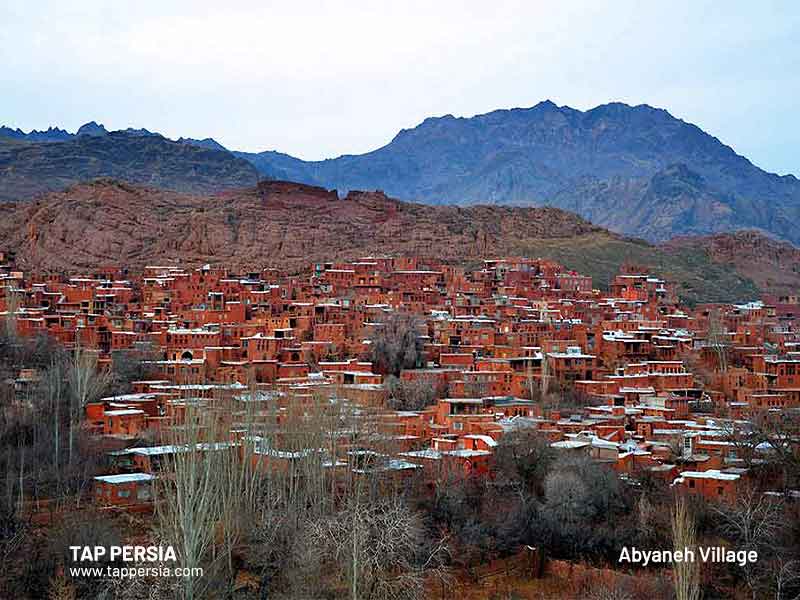
A respectable neighbor of Kashan called the Abyaneh Village has red-stepped homes and mud-brick lanes on the hillside of the magnificent mountains(Kashan tour). Each Iranian would take pride in seeing Abyaneh village and preserving a snapshot of it in his or her book since it is a must-see village in all of Iran that one cannot miss. It is like the red emerald of Iran.
About Abyaneh
The red historic Iranian town of Abyaneh makes for breathtaking visual sensations. The most important village to visit in Iran is Abyaneh. Abyaneh village is a lovely reddish and full of hues with old homes, elderly folks, and old colorful gardens in the desert to unwind and take in the dance of colors. Here, like in earlier times, people reside in red clay homes. With its temples, red mud-brick buildings, mosque, and holy shrine with turquoise-colored water, Abyaneh Avenues is like strolling through history. The Abyaneh village ethnology museum, which showcases traditional items, attire, textiles, weaving equipment, etc., is a good place to start your sightseeing tour.
Then, you can have a stroll through the rural town, which has many picturesque locations, water cisterns, mosques, and locals who welcome you and sell products while dressed in their traditional garb. Eventually arrived at the revered shrine, which had a terrace with views of the distant mountain ranges and a dry grassland with animals.
A four-season touristic spot
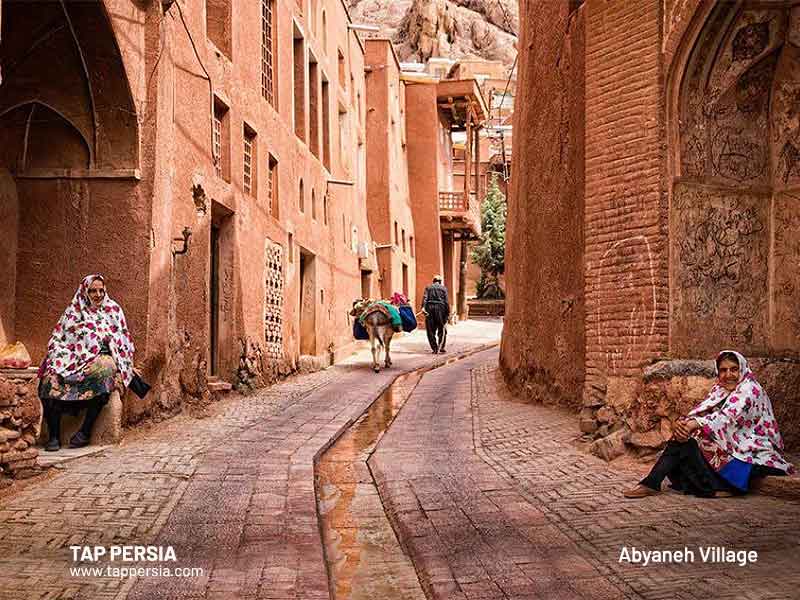
This small town enjoys happy springs, agreeably moderate summers, vibrant falls, and snowy winters. It is located on the northwest slopes of the Karkas Mountains, the highest mountain in the region. In areas with favorable weather, many fruit trees flourish and provide a living for the locals of Abyaneh village. You can sit under trees and enjoy your time beside the seasonal river that runs through Abyaneh by strolling through the village’s lanes. The Abyaneh village is a desirable location for full- or half-day visits and is practically close to Iran’s traditional tourist route.
Architecture of Abyaneh
In the census of 1981, there were 500 Abyaneh housing units. All of these homes are situated on the sloping foothill to the north of the Barzrud River. At first appearance, the Abyaneh village appears to be a multi-story village, with up to four levels in certain places. The rooms feature sash-like wooden windows and frequently have patios and verandas made of wood that look out onto the alleyways, which are now just wonderful to look at. exterior view of a house covered in red soil from a mine nearby.
Every family is expected to construct warehouses that resemble caves one kilometer away from the village’s hills since there isn’t enough room on the slanting hillsides to construct the necessary residences. The short, narrow doorways that go into the caverns, which are carved into the hills’ core, are used to store winter supplies, extra items, and cattle. There are a number of small windows all around the walls to let light into the dwelling. The modesty of living in this medieval village is shown by the dimensions of the rooms, doors, and windows.
Culture and Lifestyle
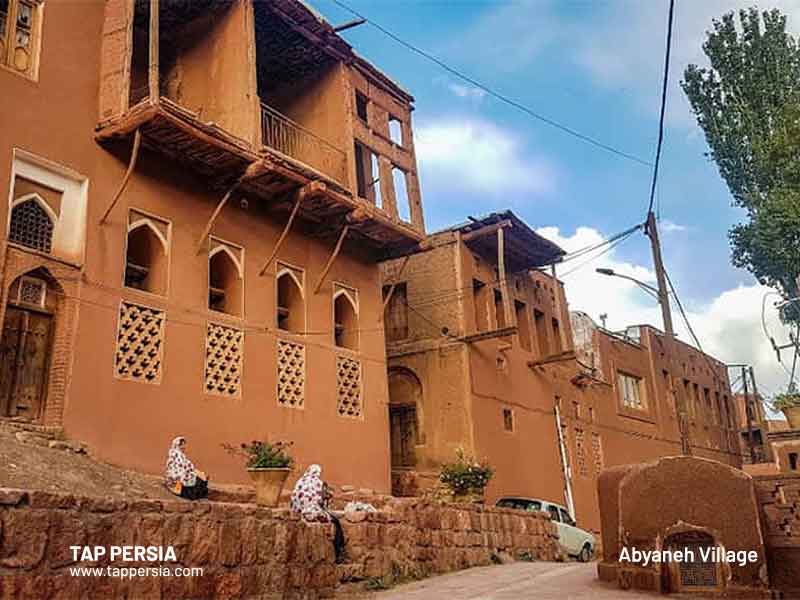
Traditional methods were used by people who engaged in agriculture, horticulture, and animal husbandry. Most women who work in the economy do so with men. The fields and gardens were irrigated by seven aqueducts. The products of this village include wheat, barley, potatoes, and many sorts of fruit, particularly apples, pears, almonds, apricots, plums, and walnuts. There are now over 30 carpet weaving workshops in Abyaneh thanks to the growth of carpet weaving in recent years. Espadrille weaving used to be one of the prominent vocations held by Abyaneh women that has since been abandoned.
The locals of Abyaneh Village
Visitors to Abyaneh Village will experience a sense of time travel after meeting the friendly residents. A village on a hillside, Abyaneh looks like it dates back centuries with its red mud façade, white arches, and lovely wooden lattice windows. Abyaneh is a well-liked travel destination for visitors from all over the world. The residents, who are mainly elderly men and women, are devoted to their customs and languages, which still contain words from the Parthian era. They also continue to dress in the manner of their forefathers. The women are dressed in a white scarf with pink floral designs, a vest, and a black under-knee skirt, while the men are dressed in loose, baggy slacks and a coat.
The primary occupations of the residents of this community are farming in their fruit gardens, caring for animals, and selling handicrafts and dried fruits that they have grown in their gardens in local shops. Although they frequently enjoy chatting with tourists, it is preferable to get their consent before taking a photo of them.
Things to do in Abyaneh Village
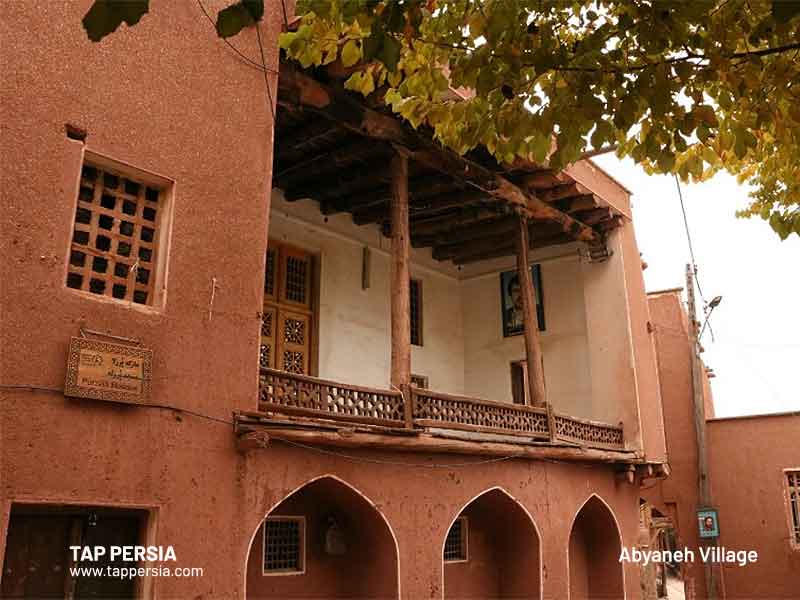
In addition to taking a leisurely stroll through the alleys of Abyaneh village and taking pleasure in the pleasant weather, there are other things you can do here, such as visiting the historic fire temple known as Harpaak. It is the most historic attraction in Abyaneh and is notable for its Chahartagh construction, which is translated as “four arches.” Another must-see attraction in the area is the Jaame Mosque of Abyaneh, also known as Mian Deh (in the center of the village). This mosque, which was built in the eleventh century, includes a well-known Mihrab that is carved from walnut wood and embellished with floral patterns and calligraphy. You can also take a stroll to the opposite bank of the river that flows beneath the village to take in the far views of the homes.
When to Visit Abyaneh
You can visit the village at any time of year because the Abyaneh village has a temperate climate. But keep in mind that spring and especially may be the finest times to travel because the scenery is beautiful and the Golab Giri (rose water producing) Festival is taking place(Kashan souvenirs). The air is fresh and cool in the spring.
Location of Abyaneh
The village of Abyaneh and the locals are the main draw for tourists. You will have a unique experience walking among red clay homes and seeing old and young people passing through alleys. You can also visit other historical structures like a mosque, two shrines, and a fire temple. It’s important to note that Abyaneh has a tourist route that runs all through the village, allowing you to experience all the wonderful aspects of this lovely location.
How to Access Abyaneh
About 80 kilometers separate Abyaneh from Kashan’s southwest side. This popular tourist destination is reachable through the Kashan-Natanz or Kashan-Isfahan freeways(Kashan Tourist Attractions).
Where to Eat
During your visit to Abyaneh, you can treat yourself to a nice lunch at the Viunj Restaurant, Domiloon Watermill and Restaurant, or the Viuna Hotel Restaurant. Try the native trout and chelo fesenjun, which is chicken cooked in a pomegranate and walnut sauce and served with rice.
Where to Stay in Abyaneh
There are two 3-star hotels in Abyaneh, the Viuna Hotel and the Abyaneh Hotel, where you may spend a romantic night in this magnificent, charming old village. These hotels offer mouthwatering Indian and Persian cuisine that is native to the area.
Abyaneh Location
The village of Abyaneh and the locals are the main draw for tourists. You will have a unique experience walking among red clay homes and seeing old and young people passing through alleys. You can also visit other historical structures like a mosque, two shrines, and a fire temple. It’s important to note that Abyaneh has a tourist route that runs all through this beautiful village, allowing you to experience all the wonderful aspects of this lovely location.
How to Get to Abyaneh
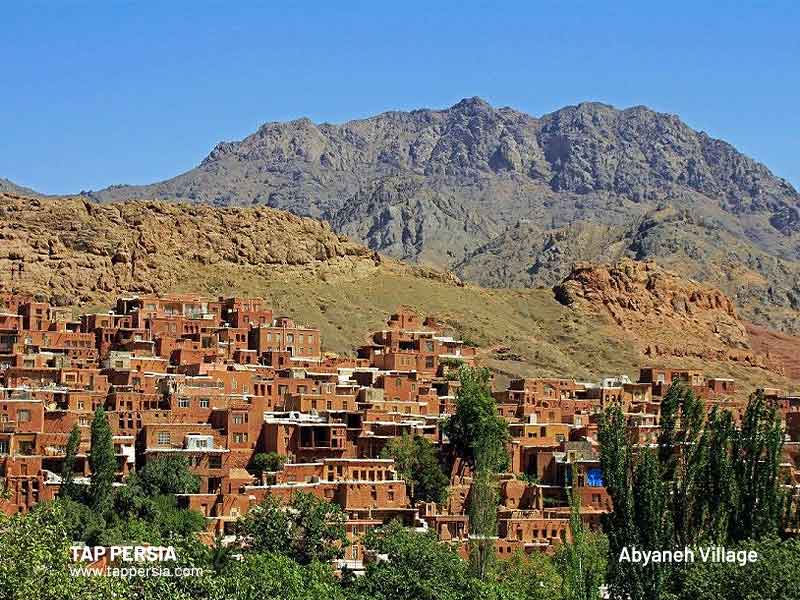
About 80 kilometers separate Abyaneh from Kashan’s southwest side. This popular tourist destination is reachable through the Kashan-Natanz or Kashan-Isfahan freeways.
As you immerse yourself in the captivating charm of Abyaneh Village, with its red clay homes and rich cultural tapestry, your journey through Iran’s historical villages doesn’t have to end here. Discover more about the historical villages of Iran, each brimming with stories, traditions, and architectural wonders that paint a vivid picture of Iran’s diverse and storied past.
Other attractions in Kashan
We are unable to cover all of Kashan’s tourist attractions in this page due to their sheer number. But we will unquestionably list a few of the most well-known for you: The following landmarks can be found in Kashan: Kashan Bazaar, Agha Bozorg Mosque, Fin Garden, Sultan Amir Ahmad Bathhouse, Noushabad Underground City, Tappeh Sialk, and Niasar(Kashan Nature).
Hotels near Abyaneh, Kashan
There are motels nearby where visitors may relax, take in the scenery, and get some rest. Two 3-star hotels, the Abyaneh Hotel and the Viuna Hotel, offer excellent lodging services to tourists. For those seeking more basic, inexpensive lodging options with greater opportunity for engagement with the locals, there are also lots of historic inns and village cottages available.
Final Thoughts
Travelers prefer not to skip visiting this village on their adventure in Iran because of the tranquil setting, breathtaking historical architecture, and friendly local residents. Abyaneh Village can be incorporated into your Iran trip schedule without deviating from it since it is situated along the route of Iran’s traditional tours between Tehran and Isfahan.



Comment (0)